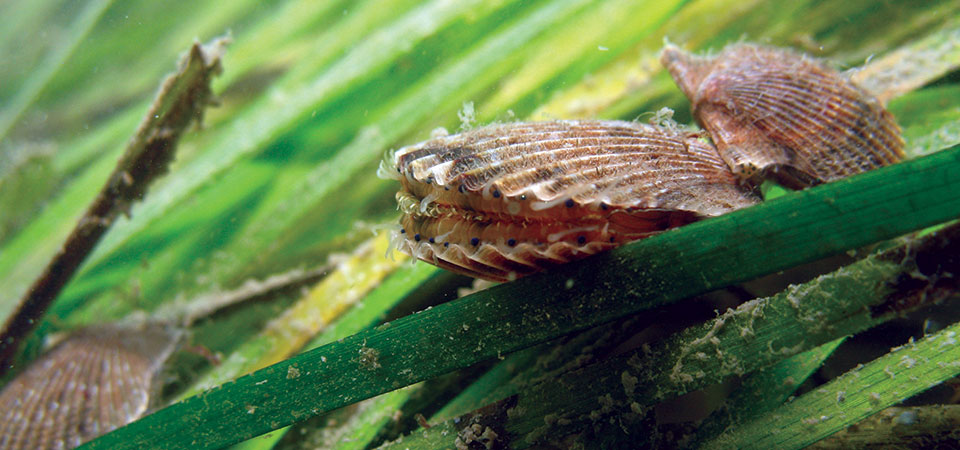Planting the Seeds of Success: the Rebirth of a Healthy Eelgrass Meadow
Ocean Shorts: Episode 12

Eelgrass and Scallops Abound!
An effort to restore eelgrass beds along Virginia's eastern shore began with people painstakingly planting 200 acres of eelgrass seeds by hand. Today, these eelgrass meadows have grown to 6,195 acres — providing a home for an estimated 240,000 bay scallops. Image credit: Bob Orth, Virginia Institute of Marine Science
Transcript
HOST: This is Ocean Shorts from NOAA’s National Ocean Service. In this episode, we have a short story about eelgrass beds in the ocean along Virginia’s eastern shore. Eelgrass is not a seaweed — it’s actually a type of blooming, underwater grass that can grow up to three feet long. It was once harvested, dried, and used for insulation in houses and as a packing material for mattresses and cushions. But today, we try to keep eelgrass in the ocean. And the more beds of eelgrass we have along our coasts, the better. That’s because eelgrass beds improve water clarity by filtering polluted runoff and by absorbing nutrients such as nitrogen and phosphorus. Eelgrass also provides crabs, scallops, fish, and other wildlife with habitat, protection from predators, nursery grounds, food, and oxygen.
HOST: Back in the early years of the 20th century, healthy eelgrass meadows thrived along the eastern shore of Virginia. This 80-mile stretch of coast along the Atlantic was a popular duck-hunting destination, tourists flocked there, and there were lots and lots of bay scallops that supported a thriving shellfish industry. Scallops that needed eelgrass to survive. But in the 1930s, this all changed after several hurricanes struck this region and then a wasting disease killed about 90 percent of the eelgrass along the Atlantic coast.
HOST: In the decades that followed, things didn’t get much better for Virginia’s eastern shore eelgrass beds. And this was a surprise, because the barrier islands along the eastern shore were protected — over the years, most of the islands were purchased for conservation by The Nature Conservancy and state and federal agencies. But after decades, the eelgrass beds still hadn’t returned. So the bay scallop fishery disappeared, too.
HOST: Laura McKay, the program manager of Virginia’s Coastal Zone Management Program, picks up the story.
LAURA MCKAY: “It turned out that eelgrass has a very poor distribution mechanism, and so it hadn’t returned because, even over 70 or 80 years, the eelgrass seeds hadn’t drifted down there. They’re very heavy and they just sink when they’re released from the reproductive shoots.”
HOST: So humans had to provide a little help. With funding from NOAA’s Coastal Zone Management Program, scientists from the Virginia Institute of Marine Science painstakingly carried over eelgrass seeds from the York River and planted them along the eastern shore.
LAURA MCKAY: “The 200 acres that they’ve planted with seed has now spread to about 5,000 acres. And because of that, we now have enough habitat that we can reintroduce the bay scallops that had been there, so we’re bringing back these resources and then we also kept an eye on the economic end of this, this being a rural and relatively poor coastal community on the eastern shore.”
[Editor's Note: As of 2015, the eelgrass meadow has grown to 6,195 acres, providing a home to an estimated 240,000 bay scallops.]
HOST: The Coastal Zone Management Act is what makes projects possible like the eelgrass restoration along Virginia’s eastern shore. It’s been around since the early 70s … and it may be the most important national coastal legislation that you’ve probably never heard of.
LAURA MCKAY: “That’s one of the bright ideas that Congress and President Nixon had in 1972 when the Coastal Zone Act was formed. It’s just brilliant that in one piece of legislation, it charged states with looking not only at environmental protection or not only at economics, but both of them together and I think that that was perhaps an idea well before its time in 1972, but I’d like to think is be coming more mainstream today — the idea that we all begin to understand that you can’t have a healthy economy without a healthy environment, and you can’t really have a healthy environment without a healthy economy. So they really do go hand in hand and this CZMA is, as far as I know, the only piece of legislation that recognizes that and promotes that.”
HOST: That was Laura McKay, program manager of Virginia’s Coastal Zone Management Program, recorded in 2012. Thanks for listening to Ocean Shorts.
